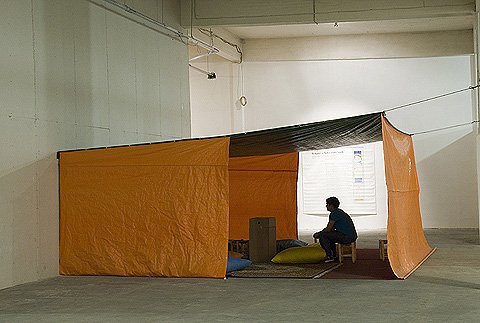Istanbul Foundation for Culture and Arts,
Sep 08, 2007 - Oct 04, 2007
Beyoglu, Istanbul, Turkey
10th Istanbul Biennial Review
by Matthew Schum
Gentrification in many respects is globalization for Hou Hanru, and the thrust of contemporary art and artists is to offer an alternative global view. As the directing curator, Hou Hanru called the 2007 Istanbul Biennial Not Only Possible, But Also Necessary: Optimism in the Age of Global War. The title proposes a peculiar set of coordinates that in the end proved to be too broad to have much meaning. But a title is a title. In practice the biennial treads on familiar thematic territory for the curator. The real challenge at this biennial was retooling the curatorial apparatus to make that familiar message applicable to Istanbul's complex history of modern development. The task is to initiate newcomers and not offend locals, as the last biennial had done quite successfully. The proposal seemed to want to critique global war, a theme epitomized as the West, while suggesting something more hopeful in the East. Istanbul was thus not just the cliched intersection of both worlds, but the line demarcating the move away from Western Imperialism from the turbulence of failed utopia to the realm of an emerging one. It was a tall order for any curator, but the impulse to tie these strains together is easy to understand given the sort of raw energy and always-pregnant potential in the city's atmosphere. A current boom in Istanbul presents in interesting dilemma that both this Istanbul Biennial and the last explored: how to experience history while it disappears? The exhibition looked to the future by reconsidering history in the guise of these contemporary forces shaping the city. A fine but important distinction emerged in the two exhibitions. Curators Charles Esche and Vasif Kortun's 2005 biennial, Istanbul, worked to be ahead of the gentrification curve. The most recent biennial appeared to be behind: it avoided tangible feelings of ambivalence and uncertainty in Istanbul about the direction of Turkey's internal and international expansion. This omission was hard to miss given the chosen themes apparent in the title and supplementary literature. It had the effect of making every generic reference to globalization at odds with the political climate. In his writing, Hou Hanru focused on mid-century Turkish modernism a term applied loosely and used to imply various things, from free-market neo-liberalism, to modern art, to the current moment. This looseness contributed to a sense that sites were disengaged with their immediate urban surroundings. This led charges that the biennial failed to appeal to Istanbul's biggest asset its complex metropolitan character. In sum, the biennial did not suture itself in a substantive way, as the last biennial had. Criticism is more or less inevitably leveled at any curator coming from outside the country, but, in comparison to the previous biennial, there was no real critical stake in shaping discussion in the local art community. One can argue about whether this complaint is fair, but it was the distinguishing factor for many artists between this and the last biennial. Like the title, Not only Possible, But Also Necessary: Optimism in the Age of Global War, the three main exhibitions were a combination of the lighthearted gestures and some heavy-handed invocations of political crises. The exhibition maintained an uncomfortable distance from current realities. While new money characterizes the city at present, widespread optimism does not. And, somehow, considerations of global war avoided the fact that Turkey is more globally engaged all the time: it being increasingly averse to the strategic alliance with the US, the turmoil on its doorstep in the Mid-East, and the calculating tough talk of the EU. This missed chance presented a familiar disjuncture between the art world' and the real world.' It also lent the parasitic exhibits that popped-up around the biennial to a role of actually delivering more pointed political content. Formulating an unspecified
|











